NNadir
NNadir's JournalA trade-off between plant and soil carbon storage under elevated CO2
The paper I'll discuss in this post is this one: Terrer, C., Phillips, R.P., Hungate, B.A. et al. A trade-off between plant and soil carbon storage under elevated CO2. Nature 591, 599–603 (2021).
The abstract is open sourced, but it is useful to excerpt here to get some abbreviations understood:
It currently seems likely to me that this Sunday, a new weekly average record for concentrations of the dangerous fossil fuel waste carbon dioxide will be set at the Mauna Loa CO2 observatory, probably near, at, or above 418 ppm. (The previous all time record was established in the week beginning February 28 of this year, 417.97 ppm.)
Last year, for the week beginning March 22, 2020, the weekly average reading at Mauna Loa was 415.52. The high for the year, which established a new record until this year, was 417.43, 1.89 ppm higher, observed for the week beginning May 24, 2020. All this suggests that we may see a weekly average reading of close to 420 ppm this year, possibly above it.
We are doing nothing to address climate change. Nothing beyond reciting the usual myths on our side of the political spectrum (so called "renewable energy" will save us) or simply engaging in lying and denial on the right ("climate change is not happening" or " it is not driven by human actions" or "it can be addressed by 'market' solutions."
We may think if we plant a lot of trees, we can ameliorate the problem, but the fact is that we are destroying forests and other wildernesses at an alarming rate, and many pristine areas are now being rendered into industrial parks for land intensive and material intensive "renewable energy," which has not worked to address climate change, is not working to address climate change, and will not work to address climate change. But even if we were not engaged in these massive efforts to destroy forests, it appears, if this paper is correct, that improvements in the mass of biomass on the surface will be offset by decreased soil carbon storage.
From the introduction to the paper:
Plant growth generally increases in response to eCO24,12, with soil nutrients identified as the dominant factor explaining variability across experiments12,13,14,15. The effect of eCO2 on SOC stocks (?soil) is more equivocal. Although the expectation is that SOC will accrue as eCO2 increases plant growth16, a few experiments show increases in ?soil, many show no change, and some even show losses7. The observed variation in ?soil across experiments is puzzling, and there is wide disagreement regarding the dominant mechanisms explaining this variation7,17,18.
A positive relationship between the effects of eCO2 on plant biomass and SOC pools is expected if increased plant production under eCO2 increases carbon inputs (litter) into the soil. Indeed, a positive relationship between inputs and SOC storage is formalized in first-order kinetics16 and is applied in most terrestrial ecosystem models19,20. Because the effect of eCO2 on plant aboveground biomass (?plant) is strongly correlated with the effect of eCO2 on litter production (Extended Data Fig. 1a, r = 0.81) and on root production21, a positive relationship between ?plant and ?soil can thus be expected from first-order kinetics. This hypothesis, however, ignores SOC losses associated with accelerated soil organic matter decomposition sometimes observed under eCO27,18. Plants acquire limiting resources from soils through carbon investment belowground in root growth, exudates and symbiotic bacteria and fungi. Accelerated decomposition of soil organic matter fuelled by plant carbon inputs can enable plant nutrient uptake (the “priming effect”22). The return on this belowground carbon investment is an increase in aboveground biomass production15. However, the priming effect can decrease SOC5. A negative relationship between ?plant and ?soil may thus emerge through the economics of plant resource acquisition.
Here, we evaluate the mechanisms of ?soil, including its relationship with ?plant, by synthesizing 268 observations of ?soil from 108 eCO2 experiments spanning the globe with coupled ?plant??soil data (Supplementary Table 1) using meta-analysis techniques...
Some graphics from the paper:
Fig. 1: Meta-analysis of the effect of eCO2 on percentage SOC across different factors.
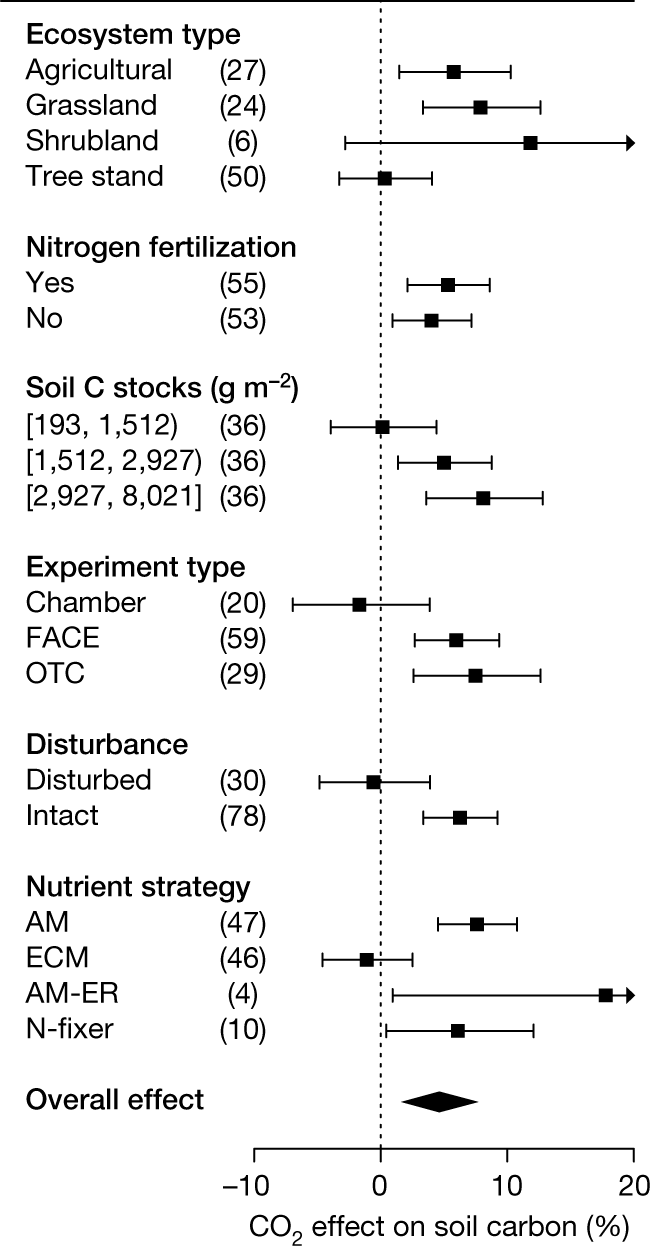
The caption:
The authors state that overall, higher CO2 levels result, according to their meta analysis, in higher soil organic carbon (SOC).
However SOC is negatively correlated with surface biomass:
Fig. 2: Elevated CO2 experiments show an inverse relationship between the effects of eCO2 on plant biomass and SOC stocks due to plant nutrient-acquisition.
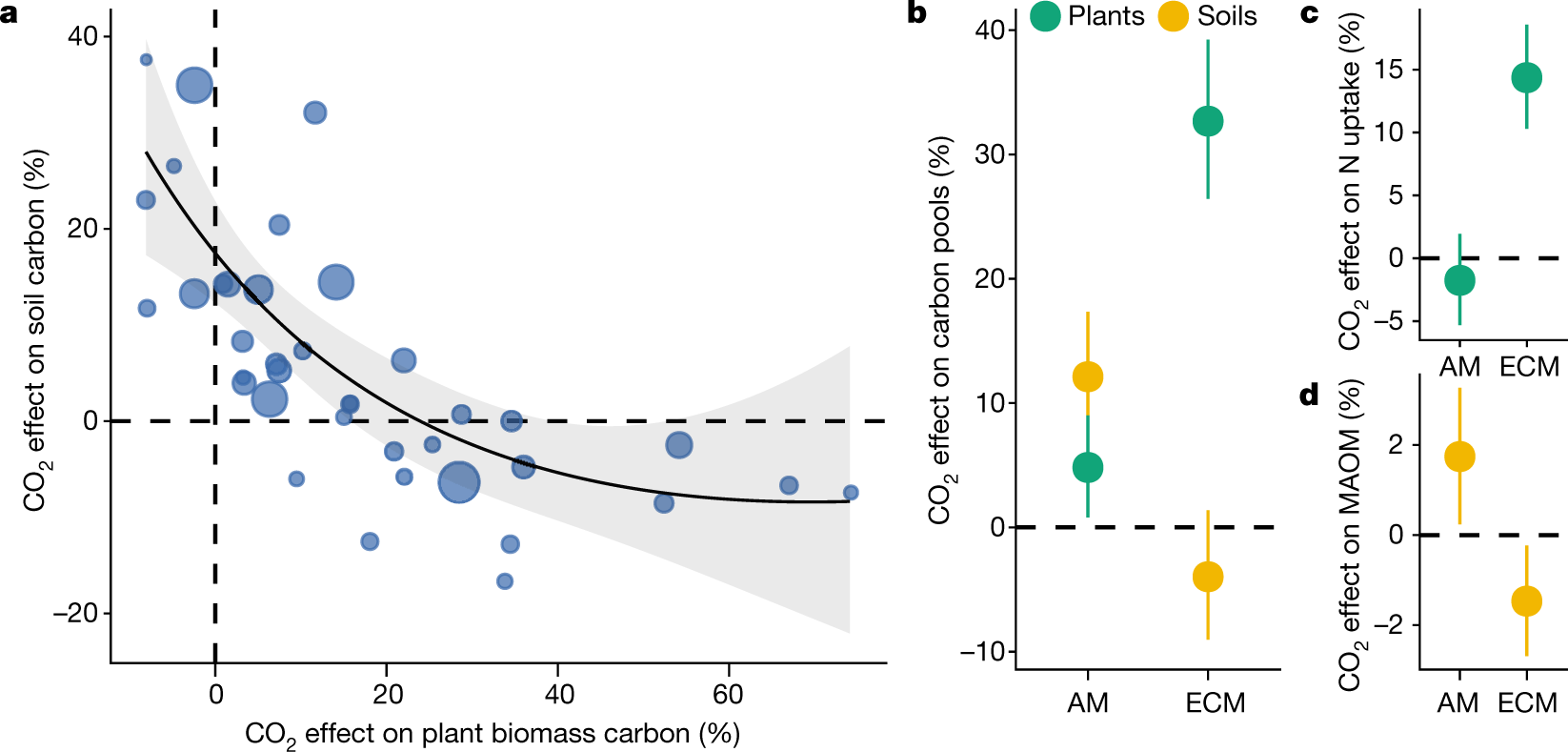
The caption:
Fig. 3: Effect of eCO2 (about 240 ppm) on SOC stocks scaled up from 108 CO2 experiments.
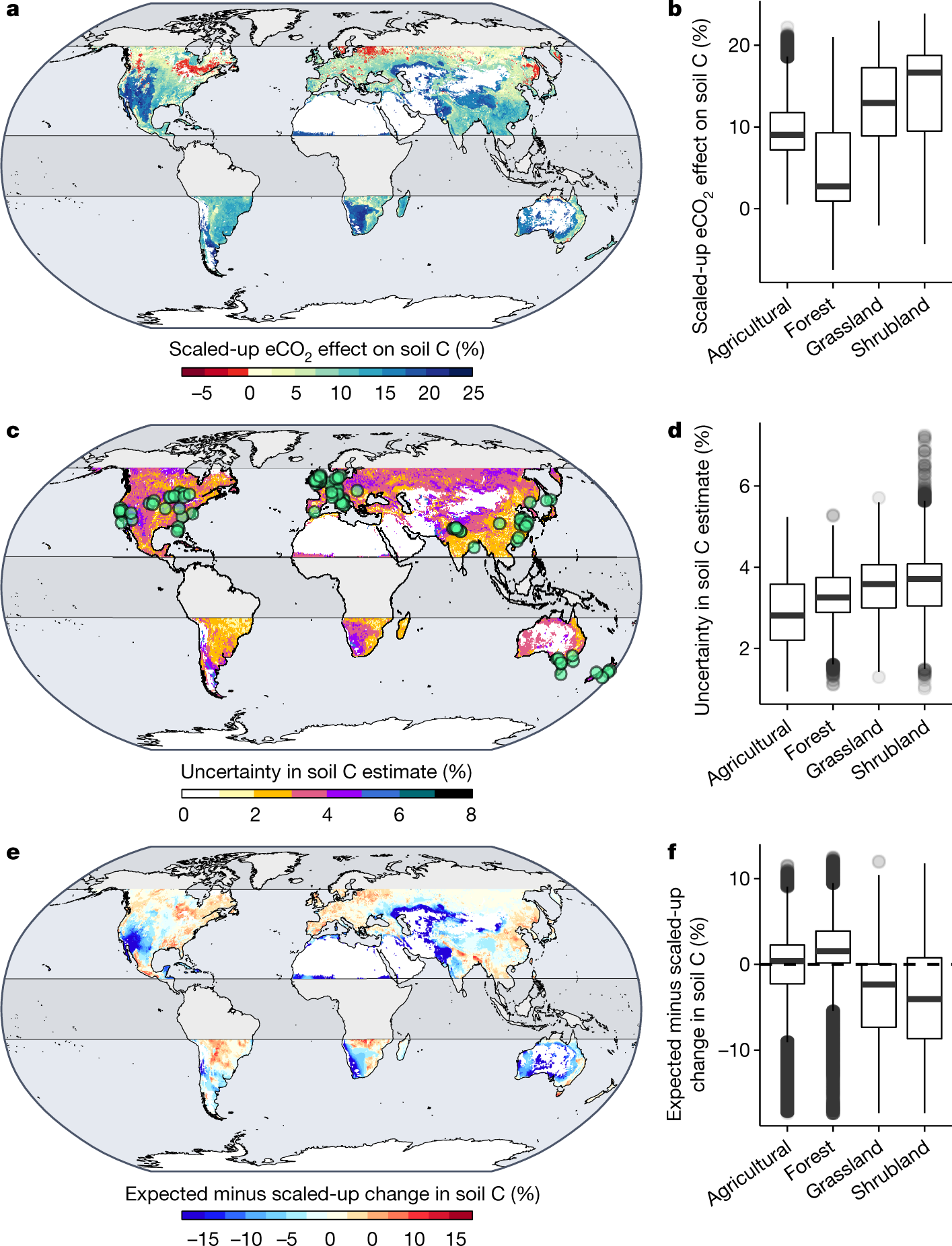
The caption:
Fig. 4: Comparison of modelled and measured relationships between aboveground biomass and SOC responses to CO2.

The caption:
Some conclusions from the paper:
This all suggests that forests have a limited capacity to address ever increasing carbon dioxide concentrations. The authors suggest that in terms of soil carbon, grasslands are more efficient than forests.
I note that it took many millions of years for the carbon we've released in the last century to be sequestered by photosynthesis and decay. This should be a sobering thought, given our propensity to believe sunlight alone can save the world. It won't be a sobering thought, but it should be.
Have a nice day tomorrow.
The National Mag Lab: The World's Strongest Magnet.
The video shows the 21 Tesla Magnet, the highest field magnet in the world. (The ion source seems surprisingly generic, but hey, at that field strength, who cares?)
If you go, leave your wallet outside.
The National Ignition Facility.
The world's largest laser is at Lawrence Livermore Laboratory. Cool video.
Dorothy Okello teaches computing to displaced people, and launches programmes to get more women...
...into science, technology and business.
From Nature News:
Engineering a brighter future for refugees and female scientists in Uganda
It's brief, and open sourced. An excerpt:
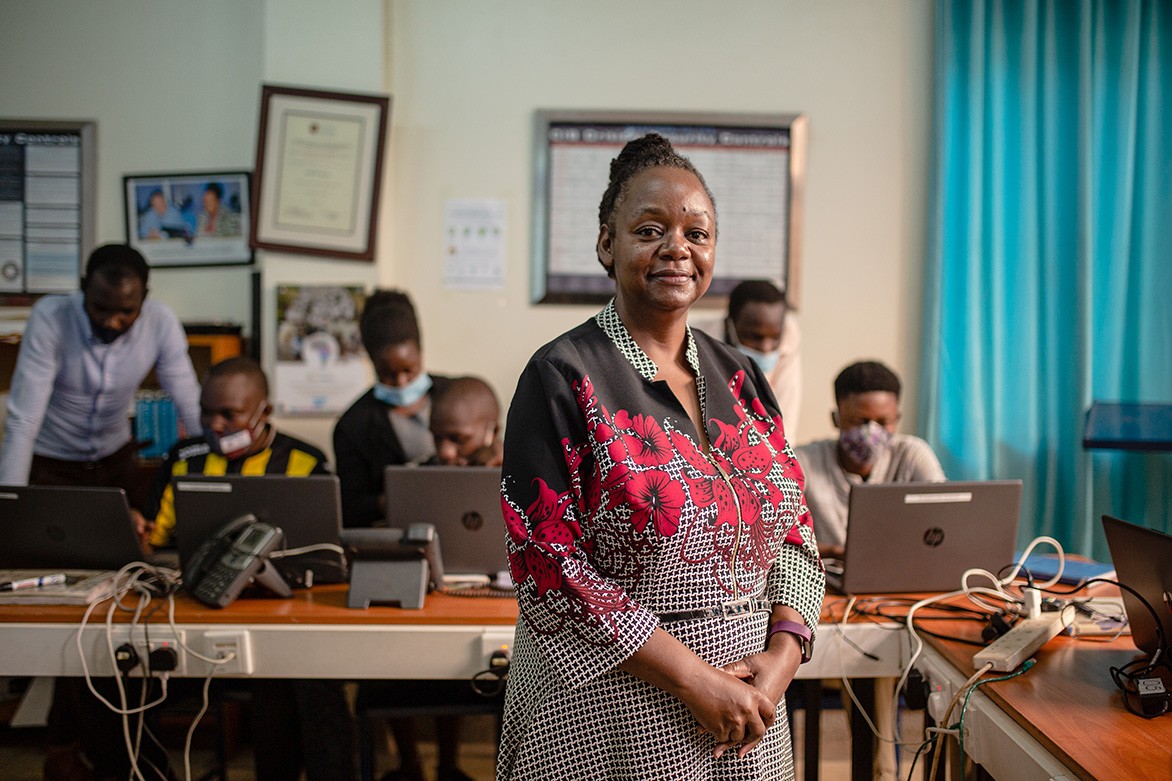
In this photo, taken in December 2020, I am reviewing students’ progress in a computer networking course at Makerere University in Kampala, Uganda, where I teach electrical engineering and telecommunication policy. The students are learning to configure computers to accommodate Voice over Internet Protocol, or online telephony. We’ve also explored the programming language Python, and technologies for radio and wireless applications...
...As a woman who works in science, I try to promote initiatives that will boost female inclusion in science and technology. One example is the Uganda Women Entrepreneurs Association, which supports aspiring female business leaders.
I’ve also launched projects to get more women into engineering. In 2017, when I was president of the Uganda Institution of Professional Engineers (UIPE), I founded its Committee of Women Engineers, Technologists and Technicians. I also helped to organize training for female engineers that tripled women’s share of the UIPE’s membership to 10% of the total.
Seventeen years later, these scientists recognized their mistake, and published a correction.
I just love these kinds of guys and gals.
I started writing a piece for here and, as sometimes happens when I start these things, it lead me through some familiar territory into all kinds of cool places I only knew vaguely or not at all.
I was writing about the very interesting actinide radiochemistry of the Nevada Nuclear Weapons test site, and somehow ended up in the Hanford tanks, after drifting through the extinct natural nuclear reactors at Oklo in Africa.
Anyway...
I have always assumed that the aqueous chemistry of technetium was dominated, almost to the point of exclusion, by the highly soluble and mobile pertechnetate ion TcO4-, an analogue of the congener permanganate, but for a long time, people, also laboring under a similar assumption, got a general sense that something was wrong with it, since the technetium in their test waste samples from the Hanford tanks wasn't behaving "as it should."
In 2004, this paper was published: Identification of the Non-Pertechnetate Species in Hanford Waste Tanks, Tc(I)?Carbonyl Complexes (Wayne W. Lukens, David K. Shuh, Norman C. Schroeder, and Kenneth R. Ashley Environmental Science & Technology 2004 38 (1), 229-233)
If you go to the link you'll see this notice highlighting in bright red: Addition/Correction. This paper has been corrected. View the notice.
The notice is dated January 28, 2021.
It reads: "The spectrum of “Tc(V) gluoconate” in Figure 2d is inaccurate. This sample is contaminated with 25–50% pertechnetate as determined by EXAFS and XANES analysis, respectively. The error does not affect the conclusions of the manuscript."
Correction to “Identification of the Non-Pertechnetate Species in Hanford Waste Tanks, Tc(I)–Carbonyl Complexes” (Wayne W. Lukens, David K. Shuh, Norman C. Schroeder, and Kenneth R. Ashley
Environmental Science & Technology 2021 55 (4), 2705-2705)
Probably this realization derived from the work one of the authors did in connection with the group's 2018 and 2020 papers, the latter being one I actually encountered in my literature search:
1. Spectroscopic Characterization of Aqua [fac-Tc(CO)3+ Complexes at High Ionic Strength ] (Sayandev Chatterjee, Gabriel B. Hall, Mark H. Engelhard, Yingge Du, Nancy M. Washton, Wayne W. Lukens, Sungsik Lee, Carolyn I. Pearce, and Tatiana G. Levitskaia Inorganic Chemistry 2018 57 (12), 6903-6912)
2. Identification and Quantification of Technetium Species in Hanford Waste Tank AN-102 (Sayandev Chatterjee, Vanessa E. Holfeltz, Gabriel B. Hall, Isaac E. Johnson, Eric D. Walter, Sungsik Lee, Benjamin Reinhart, Wayne W. Lukens, Nicholas P. Machara, and Tatiana G. Levitskaia, Analytical Chemistry 2020 92 (20), 13961-13970)
This may seem like a very small thing, and in a sense it is, since this is esoterica in the extreme, but then again, we often focus on what people do wrong, and ignore when they are magnificently right, albeit in subtle and even ordinary ways. It may never happen but some day someone may have a need to identify the spectrum technetium gluconate, perhaps in a medical setting, since technetium is an important imaging tool. Dr. Lukens and his team discovered that what they wrote in 2004 was incorrect, and to save anyone any possible pain, they made sure that they labeled their previous work as mistaken.
This is good science, and indeed, good humanity.
It is also notable that advances in knowledge have clarified the issues in this once intractable problem, the Hanford tanks that were filled in a sloppy fashion (often with poor record keeping).
Regrettably, much of this work is dedicated to finding a way to throw this technetium away - there is well over a ton of this element available only as a fission (or accelerator) product in dilute streams in the Hanford tanks - but I'm hoping that before they get to building a garbage dump for it, it occurs to people how beautiful and potentially valuable this magnificent element is, and how it might serve to help humanity solve greater and more important issues than the Hanford tanks have ever been or ever will be.
We shall see.
Have a nice evening.
Diseases Rise Where Forests Fall: Zoonotic diseases, deforestation and palm oil plantations.
The title of this post, in part, comes from the Nature News Feed, which links to a newspaper article (The Guardian) which links to a scientific paper, this one: Outbreaks of Vector-Borne and Zoonotic Diseases Are Associated With Changes in Forest Cover and Oil Palm Expansion at Global Scale (Serge Morand, Claire Lajaunie, Front. Vet. Sci., 24 March 2021 | https://doi.org/10.3389/fvets.2021.661063)
I believe this journal is open, so there is little need to talk at length about what's in it, one can form one's own opinion by opening it and reading it. (It's not overly technical.)
A few excerpts are in order however. From the introduction:
According to Curtis et al. (8) a quarter of global forest loss is due to the conversion of forest to produce commodities (beef, soy, palm oil, and wood fiber). The overall rate of this commodity-driven deforestation has not declined since 2001 (9). Forest conversion to commodities such as oil palm may affect several ecosystem functions such as carbon sequestration and soil regeneration (10). However, the loss of disease regulation during forest conversion has not been well-investigated. In Southeast Asia, a recent meta-analysis showed that increasing prevalence of vector-borne diseases such as dengue or chikungunya was associated with land conversion, including forests, to commercial plantations such as teak, rubber and oil palm (11). Nonetheless, it remains difficult to disentangle the respective influences of forest loss and conversion, other land use changes, demography, increased human and agricultural encroachments or the pressures of hunting on the rise of infectious diseases. Several studies have as exemplified that multiple factors are responsible of the outbreaks of Ebola in Africa (12, 13), Nipah (14) or Plasmodium knowlesi in Southeast Asia (15). Not only the emergence of new diseases, but also epidemics of infectious diseases appear to be linked to deforestation as recently evidenced for malaria epidemics in Brazil (16)...
An image from the paper:
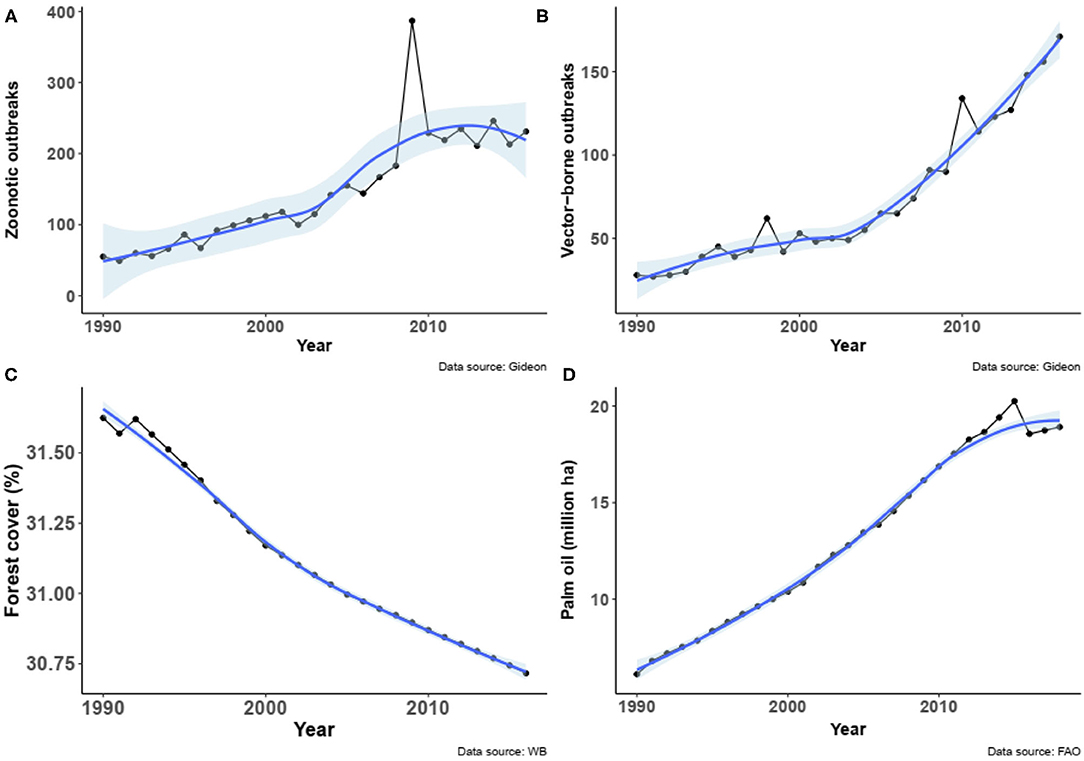
The caption:
I will comment - given my consistent views on the topic of so called "renewable energy" - that the rise in the number of palm oil plantations, which are generally planted in clear cut land in former rain forest, is very much connected with demand connected with the setting of "renewable energy portfolio standards" in Europe, under the assumption that biofuels are carbon neutral. This of course, ignores the fact that tankers traversing, say, the Suez Canal, loaded with palm oil are powered by bunker oil obtained from dangerous fossil fuels. This is explicitly discussed in the brief conclusion to this paper which I will excerpt below.
One sees a lot of webinars, seminars and papers talking about "climate justice," these days. I note that the only people left on the planet who have always survived, for generations, on so called "renewable energy" are poor people. There are reasons that rich people abandoned biofuels and other forms of so called "renewable energy" in the 19th and early 20th century. Only one of those reasons involved deforestation of Europe. Justice, such as it is, calls into question whether the rise of zoonotic diseases among the inhabitants of South East Asia, the overwhelming majority of whom could never even dream of owning a BMW X5 X540D running on "up to" B7 diesel fuel, so that Europeans can feel "green" is an issue in climate justice, as they will bear the disease burden, and not the Europeans demanding the fuel. (That BMW X5 X540D a "green car.") Just as it is the case that enslaved children in the "Democratic Republic of the Congo" dig cobalt for "green" electric cars, it is not the Europeans who suffer so Europeans, and certainly Americans, can all feel "green."
Life can be obscene, and then you die.
(It's not all fuel of course; food processing is also involved in palm oil plantations.)
The comments on palm oil plantations and biofuels from the paper:
Vijay et al. (47) have emphasized the negative impact of oil palm expansion on biodiversity, especially in Southeast Asia and South America in comparison to Africa. Our results clearly show an association between the increasing number of outbreaks of vector-borne diseases and the increase of oil palm plantations. Interestingly, among them there were countries that were not affected by deforestation, such as Thailand, or that actively promoted reforestation, such as China and Vietnam.
A meta-analysis quantified the exposure to infectious diseases in relation to land uses in Southeast Asia showing a strong effect for oil palm monoculture on the risks of infectious diseases, either zoonotic or vector-borne (46). Strong effects of oil palm monoculture were also observed for rickettsial diseases (scrub typhus, spotted fever group) and malaria. Studies have also documented increase of mosquito-borne viruses, such as Aedes albopictus and Aedes aegypti, in oil palm and rubber plantations (48, 49) favoring the spread of dengue, zika, chikungunya, and yellow fever...
...Recommendations for Science and Policy
Based on the results of our study, two main outputs should be stated. First, emerging zoonotic and vector-borne diseases are important threats, but it is also crucial to acknowledge the high burdens of neglected zoonotic and vector borne diseases in tropical countries. Second, while our study gives new support for a link between global deforestation and outbreaks of zoonotic and vector-borne diseases, our study also evidences that reforestation and plantations may also contribute to epidemics of infectious diseases.
In 2015, representatives of civil society from across Asia, Africa, and Latin America called on the European Parliament to halt the demand for biofuels in Europe and refrain from using biofuels derived from oil palm plantations considering that industrial oil palm plantations are one of the world's largest contributors to greenhouse gas emissions. While the European Union proposes to phase out palm oil-based biofuels by 2030, Malaysia follows Indonesia and prepares dispute settlement proceedings before the World Trade Organization against the European Union's proposal which constitutes a damage to the oil palm industry. Our result shows that oil palm plantations may also constitute a threat to global health by favoring zoonotic and vector-borne diseases.
Then, what is needed is a better way to stop both the loss of biodiverse native forests and a better management of afforestation to increase their contribution not only to biodiversity, or carbon sequestration, but to local livelihood and health.
By way of full disclosure, I will concede that I once gave serious thought to entering the biodiesel business, about 20 years ago.
I didn't do it, but I thought about it.
One should be able to change one's ideas as one accumulates information.
The idea that so called "renewable energy" will save the world is widely held and wildly popular. The persistence of this idea is one of the reasons that we see figures like this:
Recent Daily Average Mauna Loa CO2
March 24: Unavailable
March 23: 418.74 ppm
March 22: 417.19 ppm
March 21: 417.85 ppm
March 20: 418.46 ppm
Last Updated: March 25, 2021

That is a very, very, very scary graphic.
It is a good idea, I believe, for humanity, if we all do our best to learn before we die, for as long as we are learning, we are alive, and as long as we can leave our former ideas behind when better ideas are obviated, as old as we may be physically, we are young. It is our responsibility to the future to think of, for, and like the young.
Have a nice evening.
Coronavirus Thanks Ron DeSantis for Making It Feel So Welcome at Spring Break
“It’s been a tough couple of months for me, since Biden came in and started boosting vaccinations and mask-wearing,” the virus said. “I really needed this vacation.”
The coronavirus’s praise of DeSantis as “a fantastic host” stood in sharp contrast to its harsh criticism of the Miami Beach mayor, Dan Gelber, whom the pathogen called “a total buzzkill.”
“Dan Gelber has not made me feel welcome at all, which I find divisive and hurtful,” it said.
The coronavirus also predicted that it would not be alone in supporting DeSantis’s expected White House bid. “Every variant I talk to is excited about it,” the virus indicated.
Coronavirus Thanks Ron DeSantis for Making It Feel So Welcome at Spring Break
I want to live in a world where I can be a physicist without also being asked to speak on...racism.
A Black Physicist Is Borne Back Ceaselessly Into the PastIt's open sourced, but some excerpts:
The course was an introduction to physics for physics concentrators (Harvardspeak for “majors”). For me, I thought. But I was supposed to know how to read a circuit diagram and how to use a breadboard to build the circuit in the drawing. Of course, I had been looking through my lab kit for something with a label on it. I had not been expecting that I was supposed to just know that the slab of plastic with a bunch of holes in it was a breadboard.
This incident became part of a growing file of stories about being told I didn’t belong, along with the numerous times fellow students told me I didn’t “look like a physics concentrator.” When I complained to peers about being on the receiving end of these comments, they would then insist it was because I dressed more nicely than they expected science concentrators to dress. But my clothing was less nice than everyone else’s, and I often showed up to breakfast in my pajamas, trying to live my best version of a real-life scene in Real Genius (a favorite film about physics students). My friends and study partners refused to acknowledge the obvious: a Black woman—even a light-skinned one—violated everything we had been taught about who belonged in physics.
During winter break that year, I called my mother and said I was switching to anthropology. Another Black student had just dropped physics and switched to another concentration on the advice of their physics adviser, who suggested they would be “better suited” for it. This conversation still regularly replays in my head: my mother’s guilt-tripping insistence that she hadn’t worked a job as a night secretary, allowing me to stay jobless and enrolled in my nice magnet high school—which required a three-hour commute on the school bus—just so I could quit physics...
I am not clicking on any news item about the shooter.
I'm going with Jacinda Ardern's prescription for mass murderers. They seek attention and to the extent we deny it, we defeat them.
For me at least this murderer is a non- person.
There's a first time for everything...
I don't check the values at the Mauna Loa Carbon Dioxide Observatory every day, although I do check it weekly.
Often, but not regularly, I check the Recent Daily Average Mauna Loa CO2 in anticipation of what the weekly average data might look like the following Sunday.
Today, accessed on 3/21/21 at 6:10 pm EDT, it looked like this:
March 20: 418.46 ppm
March 19: 418.22 ppm
March 18: 418.18 ppm
March 17: 417.25 ppm
March 16: 417.31 ppm
More interesting are the hourly figures for 3/21/21, which are shown graphically:

Like I say, I don't look at this particular graph every day, but this is the first time - there is a first time for everything - that I've seen hourly readings over 420 ppm. (We will surely see weekly averages over this value by May, setting new records for the highest values for the concentration of the dangerous fossil fuel waste carbon dioxide ever recorded at the Mauna Loa observatory, but this is the first time - there may have been others recently - I've seen hourly readings that high.)
Speaking of first times, the first time that I heard that so called "renewable energy" would save the world, was when I read the famous "genius" article by the anti-nuke Amory Lovins in October 1976: Energy Strategy, the Road Last Traveled. (In 1980, he predicted that if we didn't abandon nuclear power, there would be nuclear war. Nuclear Power and Nuclear Bombs.)
I haven't experienced any nuclear wars since then, but perhaps I missed something. Let me know if you're aware of one. All the wars I've seen have been wars conducted by converting oil into weapons of mass destruction, and many have been fought to procure oil.
In October of 1976, the monthly mean concentration of the dangerous fossil fuel waste carbon dioxide in the planetary atmosphere was 328.72 ppm.
What's 90 ppm between friends?
I, um, never had much use for Amory Lovins ideas about solar heated molten salt tanks in every suburban backyard, but I will say that I agree with him about the value of energy efficiency, but for quite a different reason.
For him, it's about assholes living "efficiently" in McMansions in Snowmass, CO among the glitterati, with ever more oblivious oracular pronouncements drooling out of their mouthes.
For me, since I understand Jevon's Paradox better than a poorly educated self declared "physicist," energy efficiency is about extending energy to those who lack it, since I regard access to energy as a basic human right.
To each his own, I guess.
I don't know when I first heard that wind turbines would save the world, but it was around that time I heard - and actually believed - that solar cells would save the world. I'm sure that I began hearing about - and believing in - the wind energy scam by the early 1980's.
We used to say, "experiment trumps theory," but the the word "trump" has become an obscenity, so let me suggest that "experiment overrules theory."
If the experiment gives a result different than what the theory predicts, it's not the experiment that should be thrown out, but rather the theory.
After 50 years of cheering and chanting, the theory that so called "renewable energy" would save the world has been experimentally found to be in error.
That's a fact.
Facts matter.
Have a nice evening.
Profile Information
Gender: MaleCurrent location: New Jersey
Member since: 2002
Number of posts: 33,516